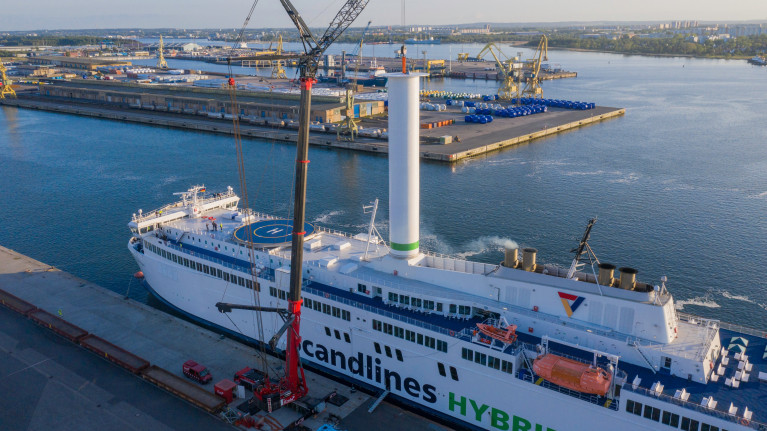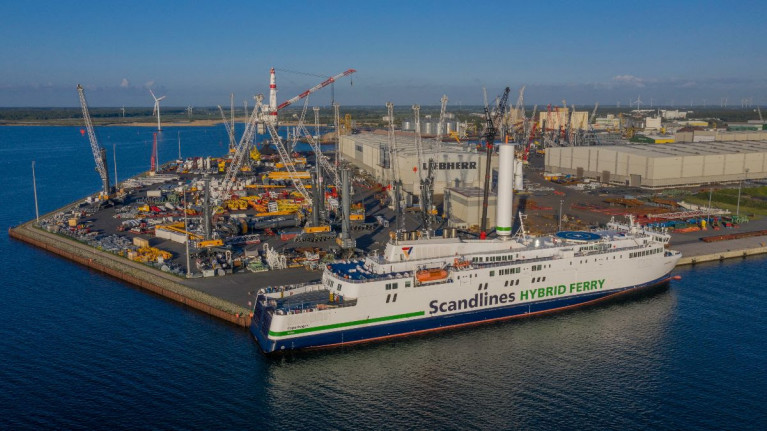Displaying items by tag: Scanlines
In the German port of Rostock, Norsepower has completed the second installation onboard a Scanlines ferry, the M/V Berlin which was carried out in just a few hours.
The installation follows a successful use of a Norsepower Rotor Sail on the sister hybrid ferry M/V Copenhagen in 2020, and a year of demonstrated results.
Since 2013, Scandlines has invested more than EUR 300 million in building and converting conventional ferries into hybrid ferries. In 2020, the ferry operator decided to adopt wind propulsion technology by installing Norsepower’s Rotor Sail on the hybrid ferry M/V Copenhagen, which operates on the Rostock-Gedser route between Germany and Denmark, a route which offers very favourable conditions for using Rotor Sails.
After just a year in operation, the Rotor Sail onboard the MV Copenhagen delivered reductions in fuel consumption, and CO2 emissions by 4% on average. Under optimal conditions, emissions reductions can be further increased to 20%. Given these positive results, Scandlines proceeded with the installation of Norsepower Rotor Sails on M/V Berlin in the port of Rostock on 16 May 2022.
Michael Guldmann Petersen, COO, Scandlines said: “After positive experiences with the Rotor Sail on the Scandlines hybrid ferry Copenhagen, Scandlines had prepared the sister ferry Berlin for a Rotor Sail as well. We are happy to see, that the installation was successfully completed and that the ferry went into operation again this morning as planned.”
Tuomas Riski, CEO, Norsepower commented on the latest installation: “Scandlines is taking the international GHG emissions reductions targets extremely seriously and is demonstrating a leading approach to investing in innovation to supersede these. Expanding its use of our Rotor Sail technology on its second vessel highlights the viability of wind power, and the significance of the emissions savings which can be achieved.”
Norsepower’s Rotor Sail solution is fully automated: the system measures the wind speed and direction, based on which it calculates whether using the Rotor Sail will reduce emissions or not. If the conditions are favourable, the Rotor Sail starts automatically. However, for specific port areas which are not suitable for Rotor Sails, the solution has settings to ensure the technology will not be activated.
The company is also currently preparing two Rotor Sails for CLdN with the installation on board a 2018-built Ro-Ro vessel (MV Delphine which Afloat reported). This project is anticipated to be completed by December 2022.
A global provider of auxiliary renewable wind propulsion systems, Norsepower Oy and market leader in green ferry operation, Scanlines today announced the successful installation of Norsepower’s Rotor Sail Solution.
According to Fathom.World, the installation was completed in just hours during a scheduled overnight stop on board the Scandlines’ hybrid ferry M/V Copenhagen.
The M/V Copenhagen, a hybrid passenger ferry operating between Rostock, Germany and Gedser, Denmark, was retrofitted with a Norsepower Rotor Sail unit measuring 30m in height and 5m in diameter. The installation was completed in a matter of hours, following meticulous preparation over the past few months.
The Norsepower Rotor Sail Solution – which can be installed on new vessels or retrofitted on existing ships – is a modernised version of the Flettner rotor, a spinning cylinder that uses the Magnus effect to harness wind power to thrust a ship.
(See Afloat's story & photos of cargoship E-Ship 1 then a newbuild also fitted with rotor sails first called to Dublin Port in August 2010 and was repeated that summer).
The installation, the fourth successfully completed by Norsepower, is estimated to reduce emissions by an estimated 4-5% on average without compromising pre-retrofit speed and voyage times.
For further reading on this ferry development click here.

























































